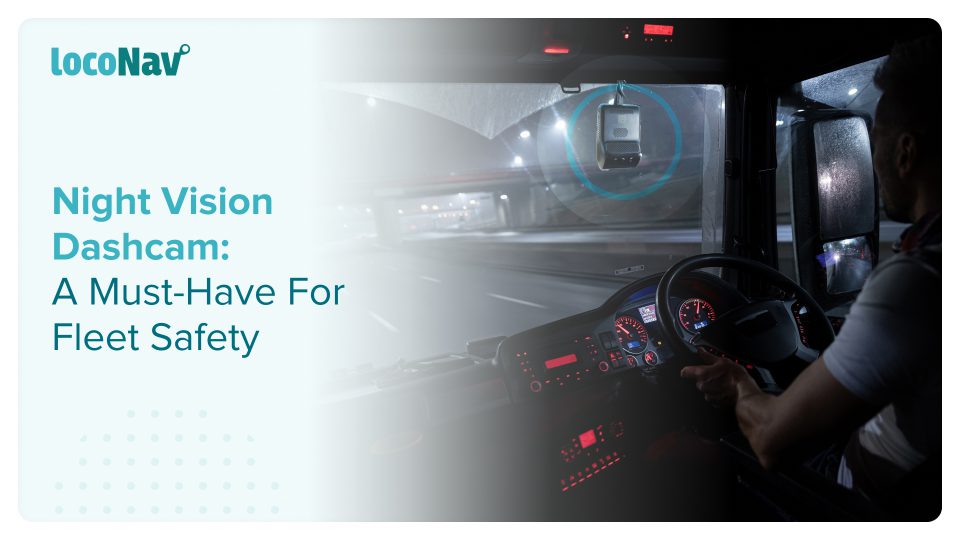

Security is often a 24-hour job that does not finish when the sun goes down. Many of our customers, particularly those in the commercial sector, require sophisticated nighttime surveillance systems to offer perimeter protection or to oversee vehicles or other assets after dark.
Given that so many incidents happen at night when vision is reduced, it is critical to invest in a dashcam capable of recording high-quality video even in low-light settings. Regrettably, many dashcams are unable to record clear footage in low light circumstances, resulting in fuzzy video with poor quality that is useless.
If you are unsure about the sort of dashcam to purchase, keep reading to find out how a night vision dashcam might benefit your fleet.
What Does Night Vision Dashcam Mean?
Night vision refers to the ability of some dashcams to capture in low light circumstances. Under low light conditions, the night vision dashcam automatically increases exposure. By detecting a lack of light with its video sensors and increasing exposure, recordings appear brighter, and so more information is caught.
If you are a fleet manager who needs to capture clear night footage, you should seek a dashcam that incorporates active illumination technology. While dashcams with HDR (high dynamic range) and other technologies are available, active illumination is the only device designed exclusively for recording at night.
Advanced Video Telematics Solutions at Ridiculously Accessible Prices!
What are the Difficulties Associated With a Standard Dashcam?
- A normal dashcam is incapable of detecting road hazards such as animals, people, and other vehicles on the road at night, which could result in a possibly fatal crash.
- Standard dashcams deprive the driver of the ability to respond sooner, which can help a driver to prevent vandalism and casualties.
- Due to the inadequacies of automobile headlights and the limits of the human eye at night, it does not alert the driver of an oncoming threat hundreds of feet away before the driver even realises it is there.
- It might be difficult to determine what happened and who was at fault in an accident, especially at night.
Types of Night Vision Dashcam Technology
The following aspects of night vision dashcams significantly improve the effectiveness of dashcams in general:
- High Dynamic Range (HDR)
When you use an HDR camera, it takes many images, each with a slightly varied amount of exposure. The camera then combines all of the photos to create one image (i.e. the final picture you see). Even in low-light settings, the end image will be a good resolution.
- Thermal Imaging
Thermal imaging relies on the heat that all objects emit. Living objects (such as deer) often radiate more heat than non-living ones (the road the deer is on). Thermal imaging cameras can detect minor temperature variations that are imperceptible to the naked eye and generate an electronic image comparable to a heatmap.
- Active Illumination
Active illumination cameras often contain built-in IR LED lights, which are undetectable to the human eye but detectable by a camera. The infrared LED lights illuminate a specific region at night or in other low-light settings, allowing the camera to record crisp video footage.
Benefits of Night Vision Dashcam Technology
To be useful, your dashcam must be able to capture clear and usable footage in less-than-ideal conditions, such as at night or in other low-light scenarios, such as early in the day or in stormy weather. A night vision dashcam provides the same benefits as regular dashcams, with the added bonus of assisting you to increase fleet safety during low-light conditions.
Night vision dashcam can benefit the following. Let’s see how.
Commercial Drivers
- Protect Drivers Against False Claims
Truck drivers have been proven to be at fault in only a quarter of the accidents in which they are involved—despite being blamed significantly more frequently. Looking at video evidence of the occurrence is the best way to determine whether or not your driver was to blame for an accident.
Because all fatal crashes involving heavy trucks occur at night, it is critical that your dashcam is capable of recording high-quality footage in low-light settings. Driver-facing dashcams, for example, have infrared LED lights incorporated in and use active illumination to record high-resolution video even at night.
Fleet Operators
- Improve Driving at Night
If your team drives at night, it is vital that you have the tools you need to spot harmful driving habits like tiredness or distracted driving during these key low-light periods. Infrared LED active illumination, for example, is used by inward-facing dashcams to record full HD footage even in low-light settings. This video material can be used for either quick intervention or long-term instruction.
- Reduced Insurance Premiums
Vehicle accidents result in expensive legal fees, productivity loss, and increased insurance prices. The good news is that onboard monitoring devices, such as night vision dashcams, have been demonstrated to reduce safety-related events and, as a result, associated expenses.
For example, having real-time access to dashcam footage of a collision can help you acquit innocent drivers and save thousands in insurance expenses. Having access to high-quality dashcam footage might also assist you in avoiding insurance penalties.
- In-Cab Alerts
Fleet management can employ in-cab speech alerts to warn drivers of potentially unsafe behaviour, such as a seat belt violation or excessive speeding.
Law Enforcement
- Review Evidence in Case of Accidents
It is often difficult to determine the cause of an accident. It is even more difficult to decide who the guilty party is. At night, in low visibility, this entire process is an ordeal. Using a night vision dashcam, law enforcement can clearly review the evidence and deal with road accidents.
FAQ
What is the difference between night vision and infrared technology?
Night vision enhances available light that reflects off of things; if there is no light, there is no enhanced image. Because infrared does not rely on ambient light, it is not affected by the same issue. Objects emit infrared light at varied levels depending on how hot their bodies are. Infrared can be used even in complete darkness.
How does a night vision dashcam work?
Under low light conditions, the night vision dashcam automatically increases exposure. By detecting a lack of light with its video sensors and increasing exposure, recordings appear brighter, and so more information is caught.
Is thermal imaging the same as night vision?
Night vision requires surrounding visible light to function correctly. Thermal imaging does not require light to function. Night vision works by increasing visible light in the surrounding area. Thermal imaging detects temperature variations between objects in its field of sight using infrared sensors.
What are the limitations of a night vision dashcam?
Night vision dashcam:
- Does not work well on a moonless night or when there is cloud cover. It works only when there is some light in the sky.
- Does not work when it is too bright. That is why night vision cameras are ineffective during the day.
- Cannot see past obstructions such as trees, fences, or plants. Your night vision camera will not detect an animal lurking behind a bush on the side of the road, for example.
- Does not work in dusty, foggy, or smoky environments.
What is the optimal resolution and frame rate for a high dashcam night vision quality?
The more pixels in a frame, the more precision the camera can detect. The top-of-the-line 622GW dashcam records in 4K resolution, which corresponds to 8.2 million pixels every frame, but the entry-level 122 dashcam records in 720p quality, which is 0.9 million pixels per frame.
